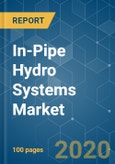The In-Pipe Hydro Systems Market size is estimated at USD 109.34 million in 2024, and is expected to reach USD 132.21 million by 2029, growing at a CAGR of 3.87% during the forecast period (2024-2029).
This product will be delivered within 2 business days.
Key Highlights
- In the medium term, factors such as increased focus on renewable power generation and rising need for efficient power generation in both commercial and industrial applications are expected to drive the demand for in-pipe hydro systems.
- On the other hand, factors such as high initial cost, interruptions caused by the natural flow of water, and shortage of water supply are expected to restrain the growth of the market studied.
- Nevertheless, expanding water infrastructure facilities across the world is creating huge opportunities for in-house power system deployment, which is expected to create opportunities in the market studied in the near future.
- North America is expected to be the largest market, with most of the demand coming from countries such as the United States and Canada.
In-Pipe Hydro Systems Market Trends
Industrial Water Systems to Witness Significant Demand
- The industrial sector offers vast business opportunities for the in-pipe hydro systems market. The requirement for water across industries, such as steel and chemicals, is widespread. Therefore, water pipeline networks in such industries can be used to install an in-pipe power generation system that can be used for self-consumption.
- As the focus across the world has increased on implementing energy efficiency measures across industries, the power generation from the water pipeline network in the industrial plants can lead to efficiency in energy consumption.
- In addition to solar photovoltaic and wind systems, in-pipe water-to-wire power systems are also being used for the integration of renewable sources at an industrial scale due to the potential to harness clean energy from excess head pressure in industrial water pipelines.
- Micro hydro power systems can be deployed in municipalities, energy-intensive industries, and agricultural irrigation districts since they can operate across a wide range of head and flow conditions. This provides a consistent amount of clean and continuous energy without the typical intermittency of wind and solar. This also aids in pipelines management and maintenance.
- The increased water needs in emerging markets, such as India and China, drive the demand for in-pipe hydro systems worldwide. According to UNESCO, the industrial and energy sectors demanded approximately 837,000 cubic meters of water in 2010. This figure is expected to double by 2050, by which the water consumption from these sectors is expected to reach some 1,381,000 cubic meters annually.
- Therefore, based on the above-mentioned factors, industrial water systems are anticipated to witness significant demand over the forecast period.
North America to Dominate the Market
- Owing to the low cost of in-pipe hydro systems, coupled with urbanization and construction, the in-pipe hydro systems market is expected to grow during the forecast period.
- North America is expected to have the maximum market share during the forecast period. This is due to increasing turbine installations, technological progress, and the presence of prominent players in the region.
- The in-pipe hydro systems segment in the renewable energy market has been gaining popularity since 2018, and these systems are being used on a large scale wherever available.
- The rising awareness about the environment and green energy generation techniques is the key driver for the in-pipe hydro systems market in the United States.
- Harvesting energy generated in a New England water utility’s pipe via pressure-reducing valves does not affect required operations. However, the process changes the monetary and renewable energy equation. Hence, the Keene (New Hampshire) facility became the first energy-neutral water treatment plant in North America.
- As the United States upgrades its aging water infrastructure, in-pipe hydropower offers new solutions to help make water infrastructure smarter, more sustainable, and more resilient.
- The small-scale hydropower by installed capacity in MW is expected to be less than 50 for Canada and 5-100 for the United States.
- Upcoming industrial and water treatment construction projects in Canada are anticipated to drive the in-pipe hydro system market. For instance, in October 2023, the governments of Canada and British Columbia announced the construction of a water treatment plant, Williams Lake, that will provide the community access to safe and healthier drinking water, with an investment of more than USD 18.06 million. The project is expected to install approximately 850 meters of new water main, providing the community with an increased supply of fresh, clean drinking water.
- Therefore, factors such as rising awareness and increasing installations, especially in the North American region, are expected to positively impact the in-pipe hydro systems market over the forecast period.
In-Pipe Hydro Systems Industry Overview
The in-pipe hydro systems market is consolidated. Some of the major players (in particular order) in the market include Leviathan Energy, Xinda Green Energy Co. Limited, Lucid Energy Inc., Rentricity Inc., and Natel Energy, among others.Additional Benefits:
- The market estimate (ME) sheet in Excel format
- 3 months of analyst support
This product will be delivered within 2 business days.
Table of Contents
1 INTRODUCTION
4 MARKET OVERVIEW
5 MARKET SEGMENTATION
6 COMPETITIVE LANDSCAPE
7 MARKET OPPORTUNITIES AND FUTURE TRENDS
Companies Mentioned (Partial List)
A selection of companies mentioned in this report includes, but is not limited to:
- Leviathan Energy
- Lucid Energy Inc.
- Rentricity Inc.
- Xinda Green Energy Co. Limited
- Natel Energy
- Tecnoturbines SL
- HS Dynamic Energy Co. Ltd
- GS-Hydro
- InPipe Energy
Methodology

LOADING...








